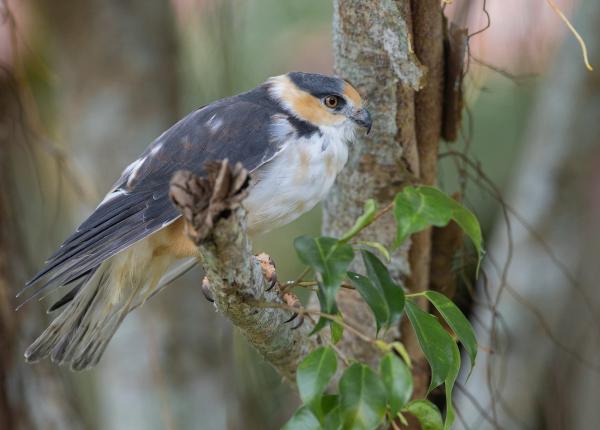Did you know?
- The Pearl Kite is also known as the Yellow-faced Kite
- It is the smallest of all the Neotropical raptors
- There are three subspecies of Pearl Kites
How The Peregrine Fund is Helping
Though The Peregrine Fund does not work directly with Pearl Kites, our efforts in scientific research, habitat conservation, education, and community development help conserve birds of prey around the world. We also supply literature to researchers from our avian research library, which helps scientists around the world gather and share important information on raptor conservation. We also support the Neotropical Raptor Network - a group that helps conserve birds of prey by improving communication and collaboration among raptor enthusiasts throughout the region!
Where They Live
The Pearl Kite is found throughout most of South America, north into Panama, with reports in Honduras and Costa Rica, and Nicaragua. It makes its home in a myriad of different habitats including open woodlands, shrubby pastures, savannas, arid scrub, agricultural areas, and even suburbs. In Trinidad, this species can be found at savanna edges bordering deciduous woodland and quite often in the vicinity of coconut palms.
What They Do
The Pearl Kite is a very small raptor, which, at first glance, appears to be quite similar to a falcon in the way it flies and perches. Given a name like "pearl kite" one would expect this bird to be quite lovely. And in fact, it is. This small kite has a bright, white belly which contrasts beautifully with the black patches on the side of its breast, its reddish-brown thighs, and the patches on its forehead and cheeks that look like a perfect blend between yellow and orange.
Like in many raptor species, the male and female coloration is identical. The best way to tell them apart is by their size. In this case, the female can be 10–20% larger than the male. However, this isn't always the case. There is some overlap in size between large males and small females.
If you ever find yourself in Pearl Kite territory, make sure to check out the utility lines, power poles and tops of snags and trees. It spends a lot of time perching conspicuously on these structures. Occasionally, it can be seen soaring very high over open areas.
Why They Need our Help
The Pearl Kite is classified as a species of Least Concern by the IUCN. This means that this species' population in doing well and is expected to continue to do well into the foreseeable future. In fact, this is one species that may benefit from some habitat alteration. When forests are cut, this creates open areas for this kite to inhabit.
What They Eat
As you would expect, a small raptor will feed mainly on small prey. Its diet mainly consists of lizards, frogs, and insects. It will occasionally prey on other bird species, and was even documented catching a Ruddy-ground Dove.
This small kite uses a number of hunting techniques. When on the hunt, it might perch high up, waiting for unsuspecting prey to walk or hop by. It might catch prey in the air, in flight reminiscent of a falcon. Similar to the American Kestrel, it may also hover over it prey before stooping to catch it.
Nest, Eggs, and Young
The Pearl Kite is a small bird and, accordingly builds a small nest. Its nest is built with fine twigs in the form of a shallow platform, which it constructs high in a tree. Both adults work together to build the nest, which requires constant repair. Even after the nestlings have hatched, the pair will continue to add new twigs to their nest.
During courtship, the male will put on a nice courtship display flight which combines fluttering and gliding. The female will sometimes participate in these lovely flight displays as well. During this time, the male will often bring the female "gifts" as well. However, these gifts don't involve flowers or chocolate - but they do involve food. Males bring food to females as part of their courtship ritual.
The female will lay 1-4 eggs, which are white with irregular brownish and grayish-violet markings. After the eggs are laid, the female will take on the important role of incubating her eggs, though the male might help from time to time - giving her short breaks throughout the day. The male, in the meantime, is responsible for finding and catching enough prey to feed himself, the female, and the young after they hatch. Though the male brings food to the nest after the nestling have hatched, the female is the one who will feed her young by delicately ripping off small pieces of meat with her beak and passing them to her young.
Depending on where the Pearl Kite lives, incubation can take anywhere from 28-35 days. After the nestlings hatch they will develop quickly and after about 5 weeks they will be ready to fly from the nest.
Pearl Kite and The World Center for Birds of Prey
Though you won't find any Pearl Kites at the World Center for Birds of Prey, this is a great place to visit, especially if you are looking for fun ways to learn about raptors. Apart from our interactive displays, tours, interesting videos and a children's room we also have several different birds of prey on display year-round. In the fall we offer live flight demonstrations and this is a great way to see birds of prey up close and in action! Knowledgeable staff and volunteers are on hand all year round to answer any questions you may have about Pearl Kites or any other birds of prey.
References:
Bierregaard, R. O. and G. M. Kirwan (2020). Pearl Kite (Gampsonyx swainsonii), version 1.0. In Birds of the World (J. del Hoyo, A. Elliott, J. Sargatal, D. A. Christie, and E. de Juana, Editors). Cornell Lab of Ornithology, Ithaca, NY, USA. https://doi.org/10.2173/bow.peakit1.01
BirdLife International. 2020. Gampsonyx swainsonii. The IUCN Red List of Threatened Species 2020: e.T22695025A168671112. https://dx.doi.org/10.2305/IUCN.UK.2020-3.RLTS.T22695025A168671112.en. Downloaded on 11 August 2021.
Global Raptor Information Network. 2021. Species account: Pearl Kite Gampsonyx swainsonii. Downloaded from http://www.globalraptors.org on 11 Aug. 2021









